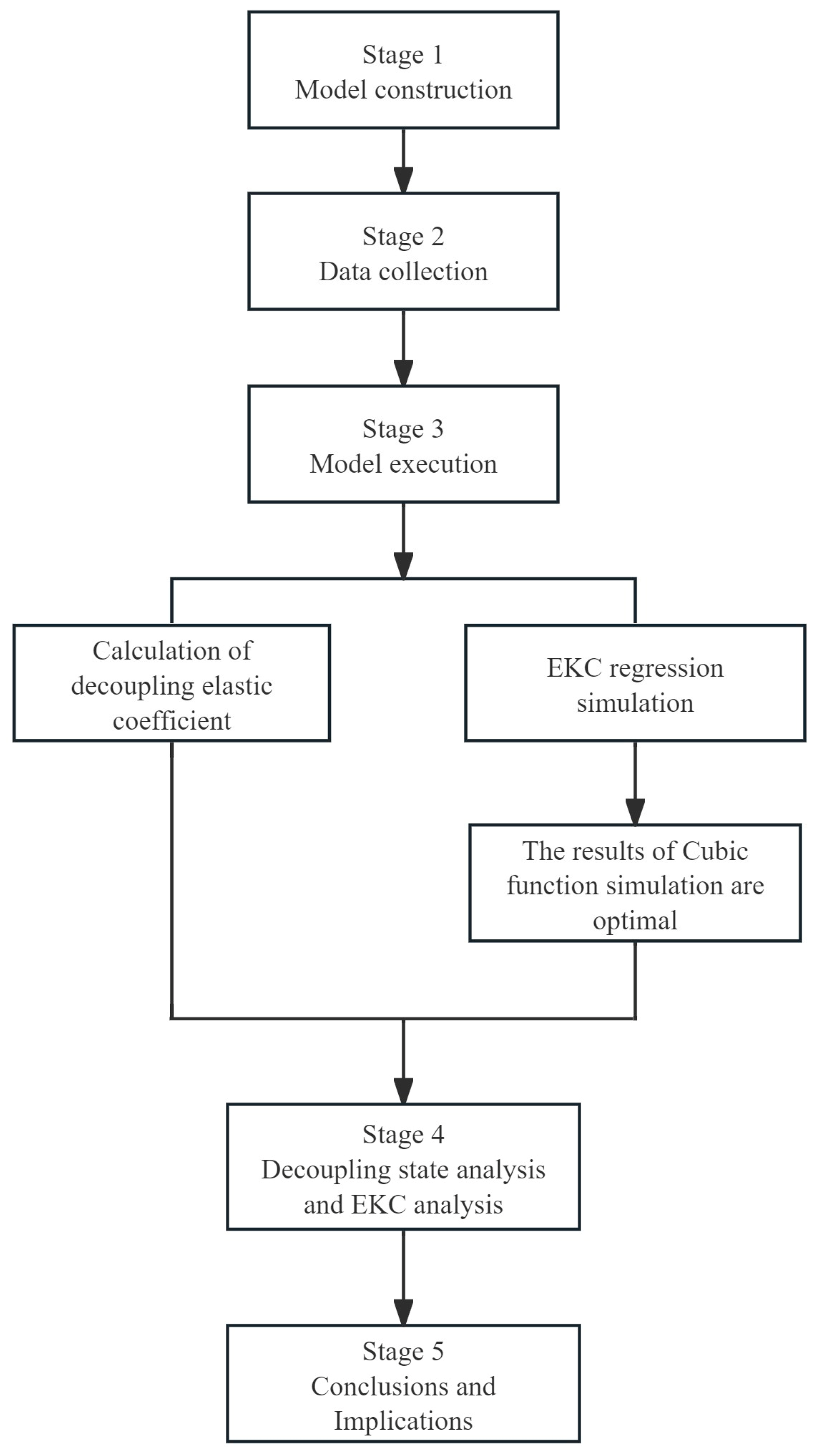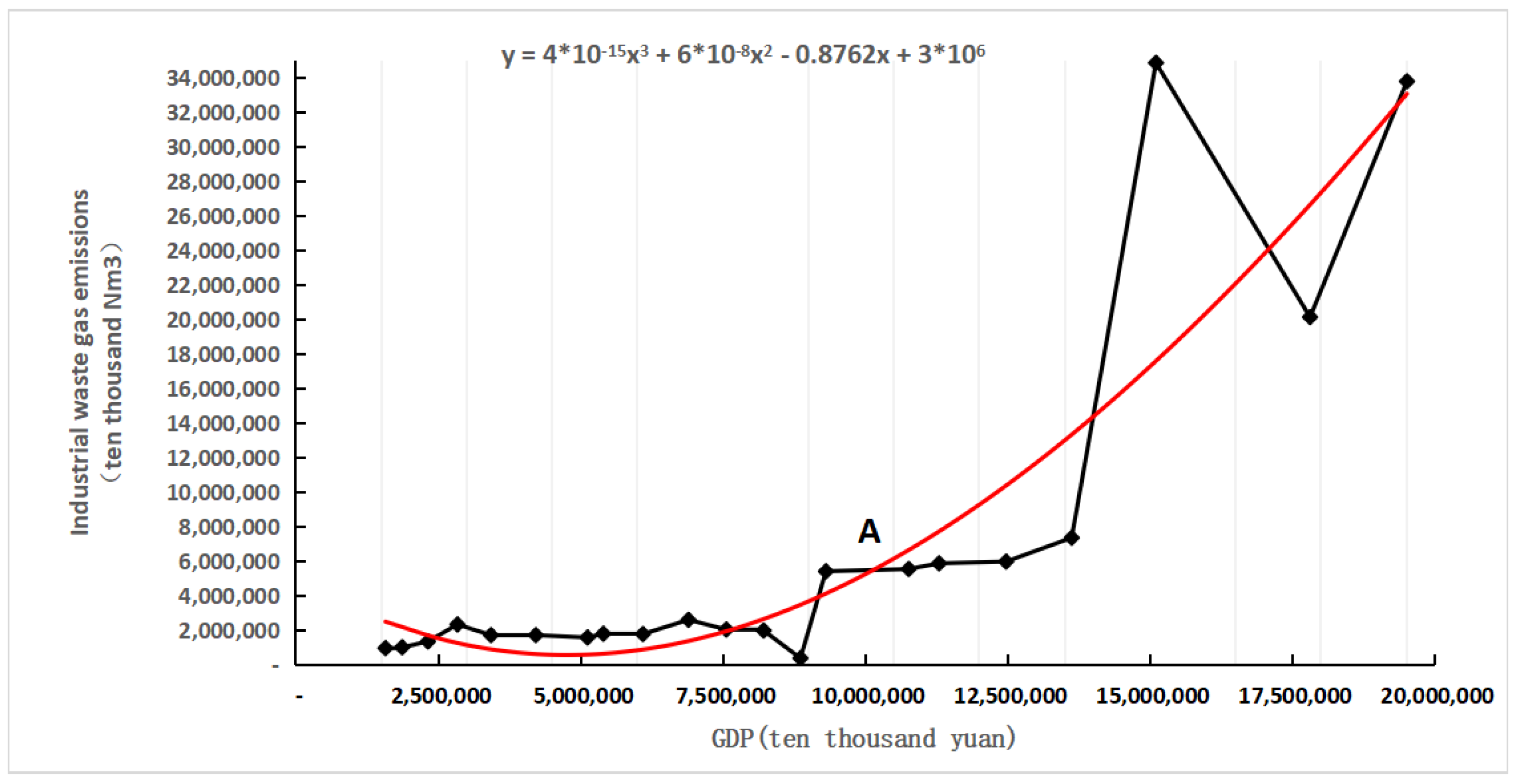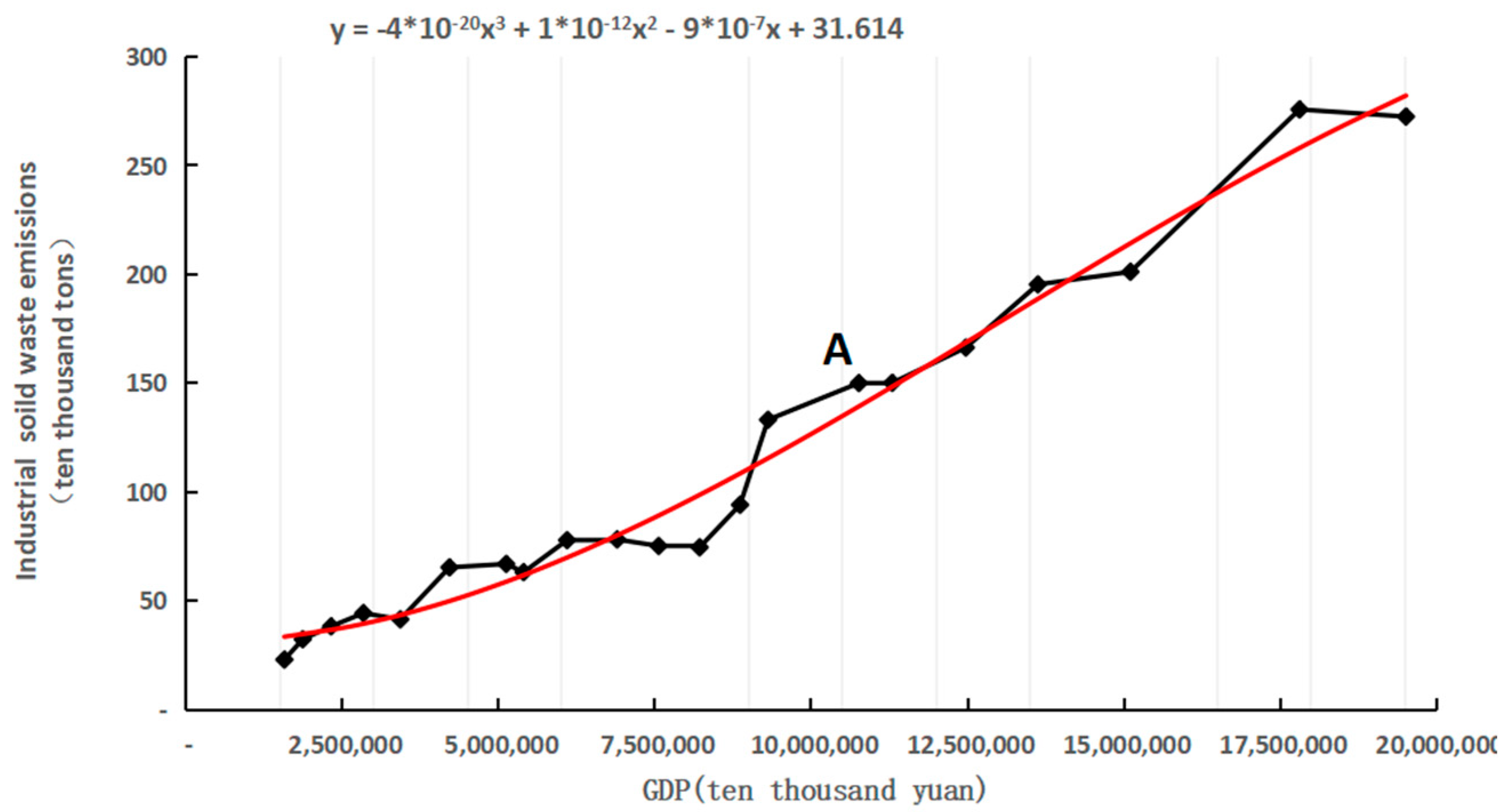Analysis of the Decoupling Relationship between Environmental Pollution and Economic Development in Island Areas: A Case Study of Zhoushan Islands, China
Abstract
1. Introduction
2. Literature Review
3. Study Design
3.1. Methods
3.1.1. Decoupling Model
3.1.2. EKC Model
3.2. Indicator Selection and Data Sources
3.3. Study Procedure
4. Results and Analysis
4.1. Measurement and Analysis of Decoupling State
4.2. Results and Analysis of EKC Curve
4.2.1. EKC Analysis of Industrial Waste Gas Emissions
4.2.2. EKC Analysis of Industrial Solid Waste Emissions
4.2.3. EKC Analysis of Industrial Wastewater Emissions
5. Conclusions and Implications
5.1. Conclusions
5.2. Implications
Author Contributions
Funding
Institutional Review Board Statement
Informed Consent Statement
Data Availability Statement
Conflicts of Interest
Correction Statement
References
- Rani, S.; Ahmed, M.K.; Xiongzhi, X.; Yuhuan, J.; Keliang, C.; Islam, M.M. Economic valuation and conservation, restoration management strategies of Saint Martin’s coral island, Bangladesh. Ocean Coast. Manag. 2020, 183, 105024. [Google Scholar] [CrossRef]
- Margaret, V.S.; Karen, F.; Simon, T. Collaboration a solution for small island developing states to address food security and economic development in the face of climate change. Ocean Coast. Manag. 2022, 221, 106132. [Google Scholar]
- Praene, P.J.; Payet, M.; Bénard-Sora, F. Sustainable transition in small island developing states: Assessing the current situation. Util. Policy 2018, 54, 86–91. [Google Scholar] [CrossRef]
- Tyedmers, E.; Malik, A.; Fry, J.; Geschke, A.; Yousefzadeh, M. Sustainable development opportunities in small island nations: A case study of the Cook Islands. J. Clean. Prod. 2020, 277, 123045. [Google Scholar] [CrossRef]
- Thanh, M.; Carl, S. Scenario-based planning for tourism development using system dynamic modelling: A case study of Cat Ba Island, Vietnam. Tour. Manag. 2016, 68, 336–354. [Google Scholar]
- Kurniawan, F.; Adrianto, L.; Bengen, D.G.; Prasetyo, L.B. The social-ecological status of small islands: An evaluation of island tourism destination management in Indonesia. Tour. Manag. Perspect. 2019, 31, 136–144. [Google Scholar] [CrossRef]
- Baek, S.; Kim, H.; Chang, J.H. Optimal Hybrid Renewable Power System for an Emerging Island of South Korea: The Case of Yeongjong Island. Sustainability 2015, 7, 13985–14001. [Google Scholar] [CrossRef]
- Kahn, G.J.; Horrocks, M.; Nieuwoudt, K.M. Agriculture, Domestic Production, and Site Function: Microfossil Analyses and Late Prehistoric Landscapes of the Society Islands. Econ. Bot. 2014, 68, 246–263. [Google Scholar] [CrossRef]
- Cherp, A.; Kopteva, I.; Mnatsakanian, R. Economic transition and environmental sustainability: Effects of economic restructuring on air pollution in the Russian Federation. J. Environ. Manag. 2003, 68, 141–151. [Google Scholar] [CrossRef] [PubMed]
- Mafizur, M.R.; Khosrul, A. Life expectancy in the ANZUS-BENELUX countries: The role of renewable energy, environmental pollution, economic growth and good governance. Renew. Energy 2022, 190, 251–260. [Google Scholar]
- Sueyoshi, T.; Yuan, Y. China’s regional sustainability and diversified resource allocation: DEA environmental assessment on economic development and air pollution. Energy Econ. 2015, 49, 239–256. [Google Scholar] [CrossRef]
- Zhao, N.; Hussien, E.; Bowen, L. The efforts of China to combat air pollution during the period of 2015–2018: A case study assessing the environmental, health and economic benefits in the Beijing-Tianjin-Hebei and surrounding “2 + 26” regions. Sci. Total Environ. 2022, 853, 158437. [Google Scholar] [CrossRef]
- OECD. Indicators to Measure Decoupling of Environmental Pressures for Economic Growth; OECD: Paris, France, 2002. [Google Scholar]
- Deng, H.; Duan, N. Evaluation mode of decoupling and its impact on circular economy. China Popul. Resour. Environ. 2004, 6, 46–49. [Google Scholar]
- Chen, M.Y. Decoupling of Energy Consumption from Economic Growth in BRICS in the Context of Novel Coronavirus Pneumonia Based on Tapio Decoupling Index. Basic Clin. Pharmacol. Toxicol. 2020, 127, 238. [Google Scholar]
- Wei, W.D.; Cai, W.Q.; Guo, Y.; Bai, C.Q.; Yang, L.Z. Decoupling relationship between energy consumption and economic growth in China’s provinces from the perspective of resource security. Resour. Policy 2020, 68, 101693. [Google Scholar] [CrossRef]
- Profillidis, V.; Botzoris, G.; Galanis, A. Decoupling of economic activity from transport-related energy consumption:an analysis for European Union member countries. Int. J. Innov. Sustain. Dev. 2018, 12, 271–286. [Google Scholar] [CrossRef]
- Scheel, C.; Aguiñaga, E.; Bello, B. Decoupling Economic Development from the Consumption of Finite Resources Using Circular Economy. A Model for Developing Countries. Sustainability 2020, 12, 1291. [Google Scholar] [CrossRef]
- Dagmawe, T.; Hawitibo, A.L. Carbon decoupling and economic growth in Africa: Evidence from production and consumption-based carbon emissions. Resour. Environ. Sustain. 2021, 6, 100040. [Google Scholar]
- Han, Y.; Zhang, J.J.; Yuan, M.J. Carbon emissions and economic growth in the Yellow River Basin: Decoupling and driving factors. Front. Environ. Sci. 2022, 10, 1089517. [Google Scholar] [CrossRef]
- Sobia, N.; Muhammad, M.; Muhammad, Z.; Ahmad, B.S.; Muddassar, S. The influence of energy consumption and economic growth on environmental degradation in BRICS countries: An application of the ARDL model and decoupling index. Environ. Sci. Pollut. Res. Int. 2021, 29, 13042–13055. [Google Scholar]
- Kokovskyy, L. Regional analysis of decoupling economic growth and pollutant emmissions into the air in Ukraine. GOT—Rev. Geogr. Ordenam. Territ. 2014, 5, 143–160. [Google Scholar] [CrossRef]
- Zhao, X.G.; Pan, Y.J.; Zhao, Q.Y.; Hu, Z.D.; Yao, H.; Yang, X.Y. Decoupling analysis between regional economic growth and resources and environmental pressure based on view of scientific development: A case study of Yunnan Province. Econ. Geogr. 2011, 31, 1196–1201. [Google Scholar]
- Liu, C.H.; Cai, W.; Zhai, M.Y.; Zhu, G.; Zhang, C.X.; Jiang, Z.G. Decoupling of wastewater eco-environmental damage and China’s economic development. Science of the Total Environment. Sci. Total Environ. 2021, 789, 147980. [Google Scholar] [CrossRef]
- Ren, J.M.; Ma, Y.J. Spatial and temporal evolution of the decoupling relationship between industrial growth and industrial air pollution in Jilin Province. J. Univ. Chin. Acad. Sci. 2019, 36, 72–81. [Google Scholar]
- Xia, Y.; Zhong, M.C. The relationship between economic development and environmental pollution decoupling theory and EKC hypothesis: On the decoupling division of prefecture-level cities in China. China Popul. Resour. Environ. 2016, 26, 8–16. [Google Scholar]
- Wang, Y.Q.; Huang, H.Z. Decoupling effect, spatial and temporal characteristics and driving factors of carbon emissions in China. Acta Ecol. Sin. 2019, 44, 2228–2243. [Google Scholar]
- Gao, X.C.; Ma, L. Research on the relationship between environmental pollution and economic development in western China based on decoupling and EKC theory. J. Southwest Univ. Natl. (Humanit. Soc. Sci. Ed.) 2014, 35, 117–122. [Google Scholar]
- Wu, K.Y.; Liu, X.W.; Zhu, Q.; Zhang, H. Delinking relationships between economic growth and environmental stress in Anhui Province: Based on MFA method. Areal Res. Dev. 2012, 31, 29–33. [Google Scholar]
- Grossman, G.M.; Krueger, A.B. Environmental Impacts of a North American, Free Trade Agreement; NBER Working Paper; No. 3914; MIT Press: Cambridge, MA, USA, 1991. [Google Scholar]
- Tenaw, D.; Beyene, A.D. Environmental sustainability and economic development in sub-Saharan Africa: A modified EKC hypothesis. Renew. Sustain. Energy Rev. 2021, 143, 110897. [Google Scholar] [CrossRef]
- Nafeesa, M.; Asma, A.; Vipin, J.; Supat, C.; Shahzad, M.S. The role of technological innovation in environmental pollution, energy consumption and sustainable economic growth: Evidence from South Asian economies. Energy Strategy Rev. 2022, 39, 100745. [Google Scholar]
- Bedakiyiba, F.B.; Enoch, N.; Boakye, A.A.; Fosu, E.O.A. The effects of economic growth, trade liberalization, and financial development on environmental sustainability in West Africa. The role of institutions. Res. Glob. 2022, 5, 100104. [Google Scholar]
- Ling, L.W.; Zhang, D.B. Study on EKC curve Test and Influencing Factors of Industrial “Three Wastes” in Guangdong Province: Based on Kaya identity and LMDI decomposition method. Ecol. Econ. 2017, 33, 161–166. [Google Scholar]
- Moutinho, V.; Varum, C.; Madaleno, M. How economic growth affects emissions? An investigation of the environmental Kuznets curve in Portuguese and Spanish economic activity sectors. Energy Policy 2017, 106, 326–344. [Google Scholar] [CrossRef]
- Mythili, G.; Mukherjee, S. Examining Environmental Kuznets Curve for river effluents in India. Environ. Dev. Sustain. 2011, 13, 627–640. [Google Scholar] [CrossRef]
- Gao, M.G.; Lu, Q.Y. Study on the decoupling relationship between water resources utilization and economic development in the Yellow River Basin. Environ. Sci. Technol. 2021, 44, 198–206. [Google Scholar]
- Wang, X.F.; Shen, D.J.; Li, W. Research on mechanism, model and application of decoupling of water resources and economic growth. China Popul. Resour. Environ. 2019, 29, 139–147. [Google Scholar]
- Liu, S.C.; Ye, Y.M.; Zhong, S.Q. Study on the Relationship between the expansion of urban construction Land and the relocation and decoupling of Economic Growth in China. Resour. Environ. Yangtze Basin 2019, 29, 2563–2571. [Google Scholar]
- Zhang, Y.; Gao, Y.J. Study on the decoupling relationship between urban land expansion and economic growth in Huaihe River Ecological Economic Belt. Resour. Environ. Yangtze Basin 2019, 32, 1573–1582. [Google Scholar]
- He, Y.Y.; Wei, Z.X. The Relationship between industrial carbon emission and economic growth: An empirical study based on speed decoupling and quantity decoupling. J. Nat. Sci. Hunan Norm. Univ. 2021, 44, 19–29. [Google Scholar]
- Dai, S.L.; Zhang, W.M. Analysis on the influence and change trend of industrial carbon emission in six provinces in Central China. Ind. Technol. Econ. 2022, 41, 152–160. [Google Scholar]
- Tapio, P. Towards a theory of decoupling: Degrees of decoupling in the EU and the case of road traffic in Finland between 1970 and 2001. Transp. Policy 2005, 12, 137–151. [Google Scholar] [CrossRef]
- Li, X.X.; Pan, X.Q. Analysis of foreign trade and environmental policies affecting China’s environmental Kuznets curve. Contemp. Financ. Econ. 2007, 78–84. [Google Scholar] [CrossRef]
- Chen, Y.; Yao, Y.; Sun, Q.X. Design of optimal environmental policy in the path of economic growth. Financ. Trade Econ. 2017, 38, 99–115. [Google Scholar]
- Chen, D.H.; Zhang, J. Environmental Kuznets curve analysis of carbon emissions in China: An empirical study based on spatial panel model. Stat. Inf. Forum 2012, 27, 48–53. [Google Scholar]
- Tian, W.; Xie, D. Testing and analysis of agricultural environment Kuznets curve in China from the perspective of carbon emission. Ecol. Econ. 2017, 33, 37–40. [Google Scholar]
- Jiang, Z.H.; Feng, Z.X. A theoretical explanation of environmental Kuznets curve based on sustainable development. Oper. Res. Manag. 2008, 4, 16–22. [Google Scholar]
- Lin, S. Low-carbon City Development and Sustainable Economic Growth: An Empirical study between the CO2 emissions in Wuhan City. Ecol. Econ. 2014, 30, 98–100. [Google Scholar]
- He, H.S. Environmental quality, environmental regulation and industrial structure optimization: Based on the panel data empirical analysis of the eastern, central and western areas of China. Areal Res. Dev. 2015, 34, 105–110. [Google Scholar]
- Jin, S.W.; Wu, P.; Jin, J.L. Environmental Kuznets curve (EKC) shape features in typical cities of Anhui Province and analysis of gray correlation degree. Acta Sci. Circumst. 2013, 33, 2068–2077. [Google Scholar]




| State I | State II | ΔY | ΔX | e | Expression | Meaning |
|---|---|---|---|---|---|---|
| Decoupling | Strong decoupling | <0 | >0 | e < 0 | The economy grows while environmental pollution decreases | The best |
| Weak decoupling | >0 | >0 | 0 < e < 0.8 | The economy grows while environmental pollution slowly increases | Good | |
| Recessive decoupling | <0 | <0 | e > 1.2 | The economy slowly declines while environmental pollution significantly decreases | Relatively good | |
| Coupling | Expansive coupling | >0 | >0 | 0.8 ≤ e < 1.2 | The economy grows while environmental pollution increases | Not bad |
| Recessive coupling | <0 | <0 | 0.8 ≤ e < 1.2 | The economy declines while environmental pollution decreases | Relatively bad | |
| Negative decoupling | Expansive negative decoupling | >0 | >0 | e > 1.2 | The economy slowly grows while environmental pollution significantly increases | Bad |
| Weak negative decoupling | <0 | <0 | 0 ≤ e < 0.8 | The economy declines while environmental pollution slowly decreases | Very bad | |
| Strong negative decoupling | >0 | <0 | e < 0 | The economy declines while environmental pollution increases | The worst |
| No. | β1, β2, β3 | Relationship |
|---|---|---|
| 1 | β1 > 0, β2 < 0, β3 > 0 | N-shaped curve |
| 2 | β1 < 0, β2 > 0, β3 < 0 | Inverted N-shaped curve |
| 3 | β1 > 0, β2 < 0, β3 = 0 | Inverted U-shaped curve |
| 4 | β1 < 0, β2 > 0, β3 = 0 | U-shaped curve |
| 5 | β1 ≠ 0, β2 = β3 = 0 | Linear |
| Year | Industrial Waste Gas | Decoupling State | Industrial Solid Waste | Decoupling State | Industrial Waste Water | Decoupling State |
|---|---|---|---|---|---|---|
| 2002 | −0.496 | ① | 0.543 | ② | 0.658 | ② |
| 2003 | 0.278 | ② | 2.188 | ③ | −0.439 | ① |
| 2004 | 1.406 | ③ | 0.751 | ② | 0.344 | ② |
| 2005 | 3.344 | ③ | 0.713 | ② | 3.296 | ③ |
| 2006 | −1.288 | ① | −0.310 | ① | −0.124 | ① |
| 2007 | 0.003 | ② | 2.508 | ③ | −0.167 | ① |
| 2008 | −0.383 | ① | 0.112 | ② | 0.446 | ② |
| 2009 | 2.608 | ③ | −1.039 | ① | 0.080 | ② |
| 2010 | −0.091 | ① | 1.810 | ③ | −1.519 | ① |
| 2011 | 3.590 | ③ | 0.030 | ② | 3.223 | ③ |
| 2012 | −2.258 | ① | −0.394 | ① | −0.850 | ① |
| 2013 | −0.336 | ① | −0.095 | ① | 0.846 | ④ |
| 2014 | 0.912 | ④ | −1.343 | ① | −2.073 | ① |
| 2015 | 30.990 | ③ | 11.256 | ③ | 5.086 | ③ |
| 2016 | 0.159 | ② | 1.083 | ④ | −2.221 | ① |
| 2017 | 1.193 | ③ | 0.569 | ② | −2.651 | ① |
| 2018 | 0.165 | ② | 1.529 | ③ | −0.855 | ① |
| 2019 | 2.328 | ③ | 2.057 | ③ | 2.731 | ③ |
| 2020 | 34.528 | ③ | 0.273 | ② | 2.118 | ③ |
| 2021 | −3.305 | ① | 2.901 | ③ | −1.066 | ① |
| 2022 | 7.103 | ③ | −0.126 | ① | 5.514 | ③ |
| Environmental Indicators | R2 | F Test Value | ||
|---|---|---|---|---|
| Quadratic Function | Cubic Function | Logarithmic Function | Cubic Function | |
| Industrial waste gas emissions | 0.793 | 0.793 | 0.398 | 21.749 ** |
| Industrial solid waste emissions | 0.974 | 0.978 | 0.784 | 248.600 ** |
| Industrial waste water emissions | 0.147 | 0.647 | 0.205 | 10.397 ** |
Disclaimer/Publisher’s Note: The statements, opinions and data contained in all publications are solely those of the individual author(s) and contributor(s) and not of MDPI and/or the editor(s). MDPI and/or the editor(s) disclaim responsibility for any injury to people or property resulting from any ideas, methods, instructions or products referred to in the content. |
© 2024 by the authors. Licensee MDPI, Basel, Switzerland. This article is an open access article distributed under the terms and conditions of the Creative Commons Attribution (CC BY) license (https://creativecommons.org/licenses/by/4.0/).
Share and Cite
Li, F.; Qi, D.; He, Y. Analysis of the Decoupling Relationship between Environmental Pollution and Economic Development in Island Areas: A Case Study of Zhoushan Islands, China. Sustainability 2024, 16, 5567. https://doi.org/10.3390/su16135567
Li F, Qi D, He Y. Analysis of the Decoupling Relationship between Environmental Pollution and Economic Development in Island Areas: A Case Study of Zhoushan Islands, China. Sustainability. 2024; 16(13):5567. https://doi.org/10.3390/su16135567
Chicago/Turabian StyleLi, Fan, Danxuan Qi, and Yixiong He. 2024. "Analysis of the Decoupling Relationship between Environmental Pollution and Economic Development in Island Areas: A Case Study of Zhoushan Islands, China" Sustainability 16, no. 13: 5567. https://doi.org/10.3390/su16135567
APA StyleLi, F., Qi, D., & He, Y. (2024). Analysis of the Decoupling Relationship between Environmental Pollution and Economic Development in Island Areas: A Case Study of Zhoushan Islands, China. Sustainability, 16(13), 5567. https://doi.org/10.3390/su16135567





